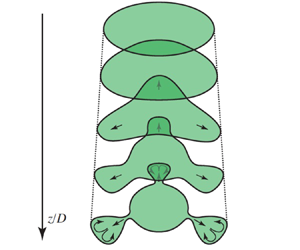Published online by Cambridge University Press: 15 May 2023

It is known that, apart from the growth of instability modes, the non-modal (algebraic) mechanism of linear growth plays an important role in near-wall flows. In unbounded flows, including submerged jets, the theoretical analysis of the non-modal growth mechanism started only in the last decade; this mechanism has not yet been identified in experiments. In the present work, experiments were conducted on the excitation of a non-modal ‘lift-up’ growth mechanism. Special wavy structures (deflectors) were introduced into a laminar round submerged jet, which excited a roller-like transverse motion. Based on experimental results, we definitely identify the non-modal ‘lift-up’ growth mechanism of introduced disturbances. The development of perturbations in the experiment qualitatively corresponds to the theoretically calculated optimal perturbations. The features of the transition to turbulence caused by non-modal growth are considered.